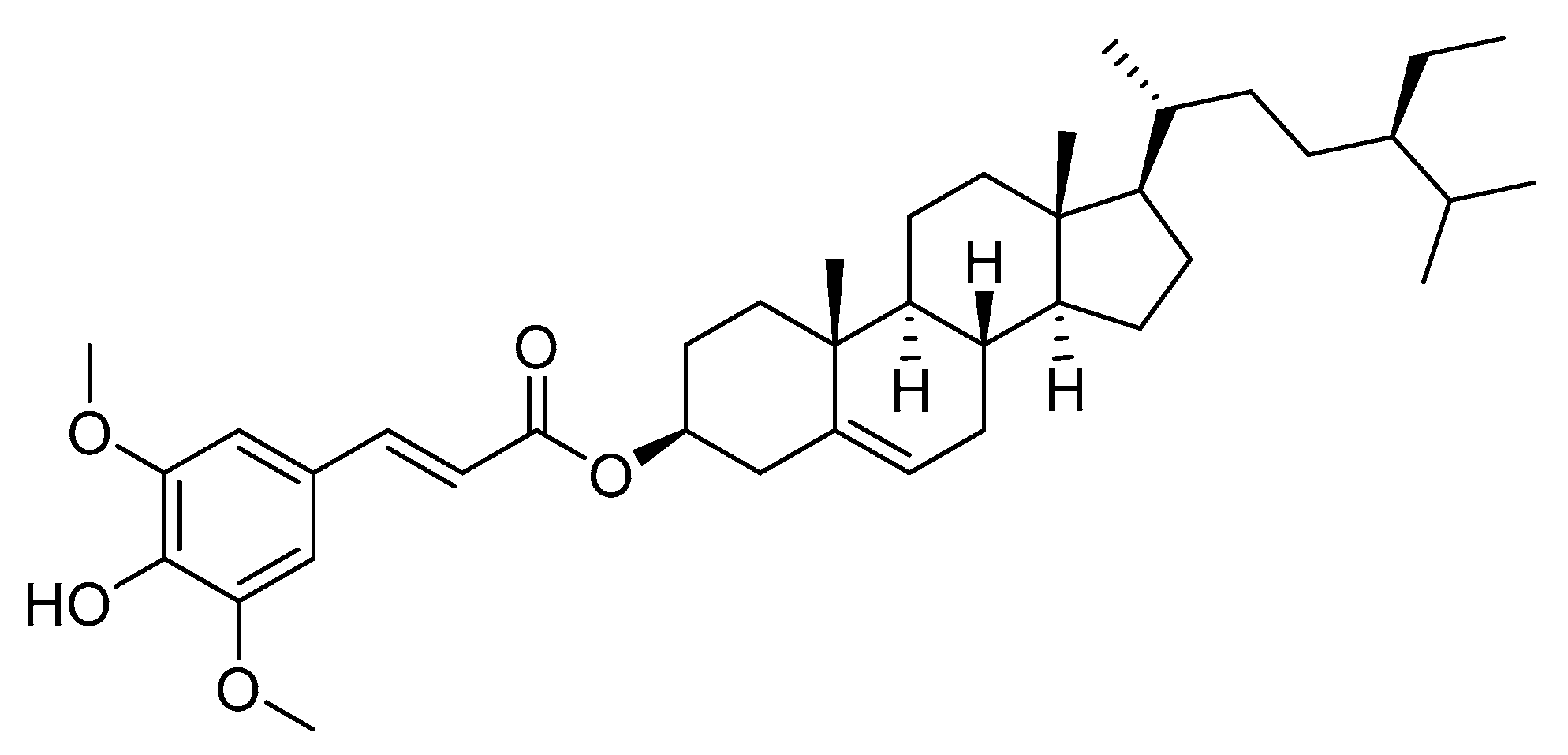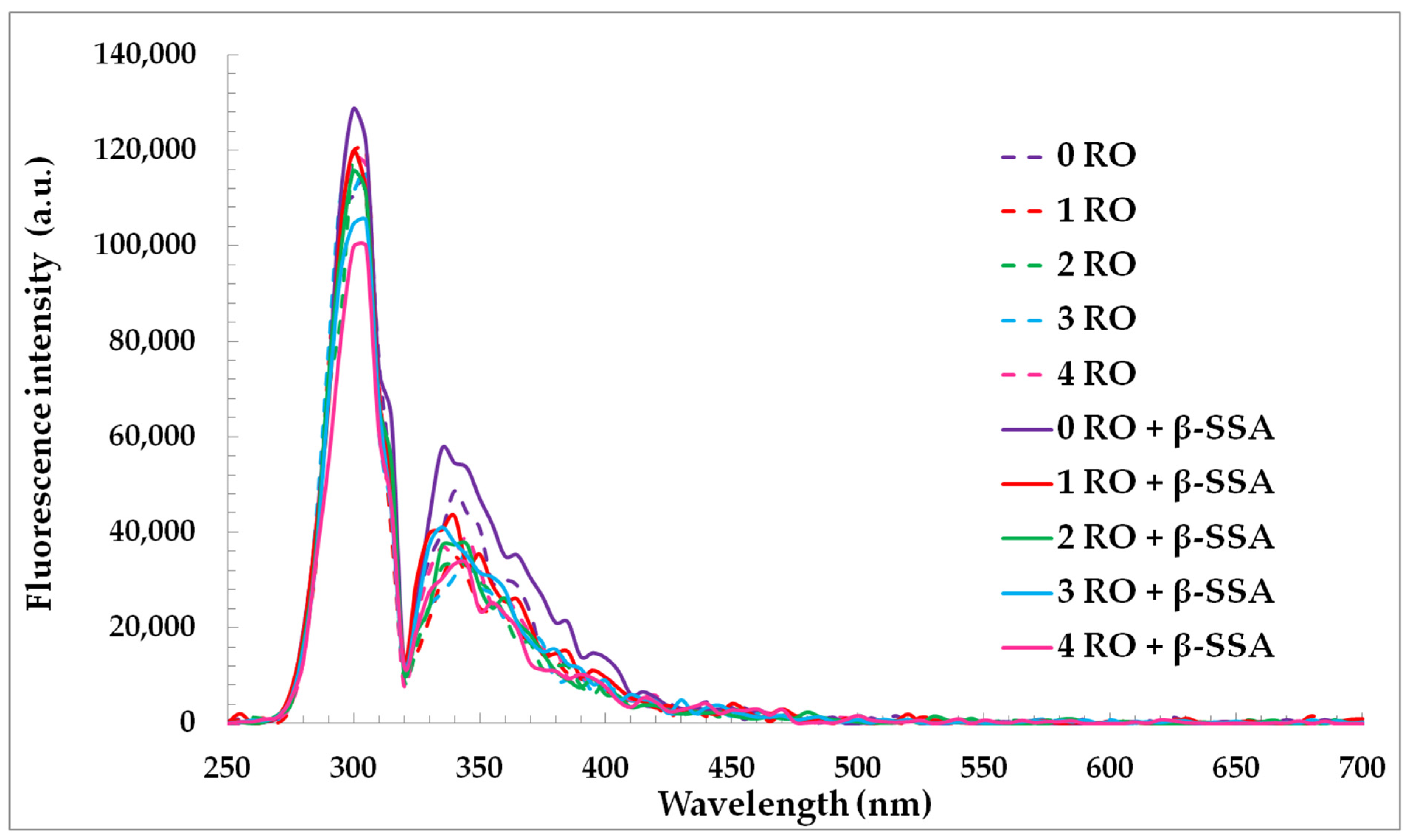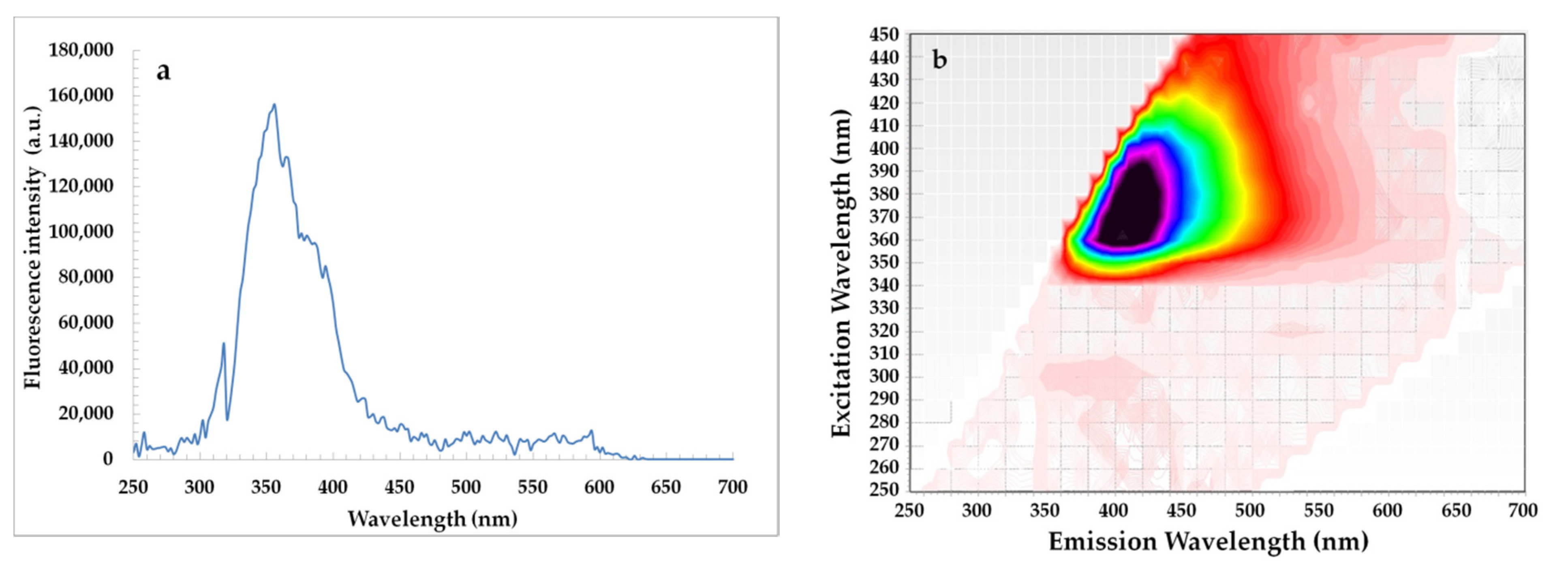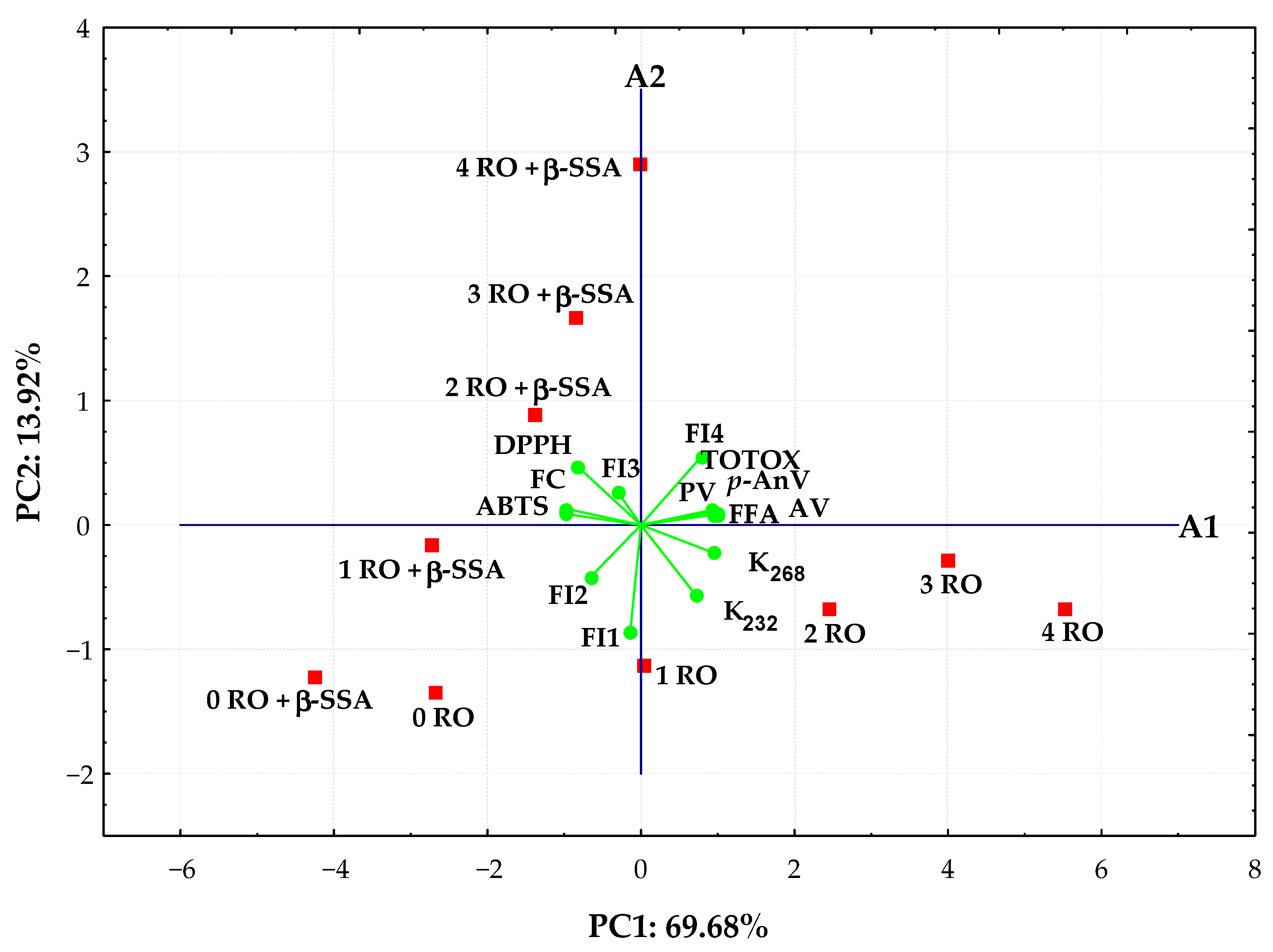Steryl Sinapate as a New Antioxidant to Improve Rapeseed Oil Quality during Accelerated Shelf Life
Abstract
1. Introduction
2. Materials and Methods
2.1. Reagents and Materials
2.2. Synthesis of β-Sitosteryl Sinapate
- Synthesis of 4-O-acetylsinapic acid
- 2.
- Synthesis of β-sitosteryl (4-O-acetyl)sinapate
- 3.
- Synthesis of β-sitosteryl sinapate
2.3. Accelerated Storage of Oil Samples
2.4. Chemical Analysis of Oil Samples
2.5. Antioxidant Activity of Oil Samples
2.6. Fluorescence Studies of Oil Samples
2.7. Statistical Analysis
3. Results and Discussion
3.1. Changes in Chemical Parameters of Rapeseed Oils Without and With Steryl Ester during Accelerated Storage
3.2. Changes in Antioxidant Activity of Rapeseed Oils Without and With Steryl Ester during Accelerated Storage
3.3. Fluorescence Characteristics of Rapeseed Oils Without and With Steryl Ester during Accelerated Storage
3.4. Principal Component Analysis
4. Conclusions
Author Contributions
Funding
Institutional Review Board Statement
Informed Consent Statement
Data Availability Statement
Acknowledgments
Conflicts of Interest
References
- Roszkowska, B.; Tańska, M.; Czaplicki, S.; Konopka, I. Variation in the composition and oxidative stability of commercial rapeseed oils during their shelf life. Eur. J. Lipid Sci. Technol. 2015, 117, 673–683. [Google Scholar] [CrossRef]
- Chen, Y.; Thiyam-Hollander, U.; Barthet, V.J.; Aachary, A.A. Value-added potential of expeller-pressed canola oil refining: Characterization of sinapic acid derivatives and tocopherols from byproducts. J. Agric. Food Chem. 2014, 62, 9800–9807. [Google Scholar] [CrossRef] [PubMed]
- Mao, X.; Chen, W.; Huyan, Z.; Hussain Sherazi, S.T.; Yu, X. Impact of linolenic acid on oxidative stability of rapeseed oils. J. Food Sci. Technol. 2020, 57, 3184–3192. [Google Scholar] [CrossRef]
- Li, X.Q.; Ji, C.; Sun, Y.Y.; Yang, M.L.; Chu, X.G. Analysis of synthetic antioxidants and preservatives in edible vegetable oil by HPLC/TOF-MS. Food Chem. 2009, 113, 692–700. [Google Scholar]
- Tańska, M.; Mikołajczak, N.; Konopka, I. Comparison of the effect of sinapic and ferulic acids derivatives (4-vinylsyringol vs. 4-vinylguaiacol) as antioxidants of rapeseed, flaxseed, and extra virgin olive oils. Food Chem. 2018, 240, 679–685. [Google Scholar] [CrossRef]
- Kowalski, R.; Kowalska, G.; Pankiewicz, U.; Mazurek, A.; Włodarczyk-Stasiak, M.; Sujka, M.; Wyrostek, J. The effect of an addition of marjoram oil on stabilization fatty acids profile of rapeseed oil. LWT Food Sci. Technol. 2019, 109, 225–232. [Google Scholar] [CrossRef]
- Jia, C.; Li, J.; Zhang, M.; Ma, W.; Zhao, S.; Liu, R.; Rong, J.; Li, X. Antioxidant properties of the extracts of vine tea (Ampelopsis grossedentata) with the different color characteristics and inhibition of rapeseed and sunflower oil oxidation. LWT Food Sci. Technol. 2021, 136, 110292. [Google Scholar] [CrossRef]
- Agregán, R.; Lorenzo, J.M.; Munekata, P.E.S.; Dominguez, R.; Carballo, J.; Franco, D. Assessment of the antioxidant activity of Bifurcaria bifurcata aqueous extract on canola oil. Food Res. Int. 2017, 99, 1095–1102. [Google Scholar] [CrossRef] [PubMed]
- Aladedunye, F.; Matthäus, B. Phenolic extracts from Sorbus aucuparia (L.) and Malus baccata (L.) berries: Antioxidant activity and performance in rapeseed oil during frying and storage. Food Chem. 2014, 159, 273–281. [Google Scholar] [CrossRef] [PubMed]
- Maleki, M.; Ariaii, P.; Fallah, H. Effects of celery extracts on the oxidative stability of canola oil under thermal condition. J. Food Process. Preserv. 2016, 40, 531–540. [Google Scholar] [CrossRef]
- Rad, A.H.; Ebrahimi, B.; Homayoonpour, F.; Tabrizi, A.; Salmasi, D.A.; Baharbanafshe, M. Formulation of stable frying oil for food industry by using various edible oils and antioxidants. Curr. Nutr. Food Sci. 2019, 15, 672–677. [Google Scholar] [CrossRef]
- Önal, B.; Ergin, G. Antioxidative effects of a-tocopherol and ascorbyl palmitate on thermal oxidation of canola oil. Nahr.-Food 2002, 46, 420–426. [Google Scholar] [CrossRef]
- Hawrysh, Z.J.; Erin, M.K.; Lin, Y.C.; Hardin, R.T. Propyl gallate and ascorbyl palmitate affect stability of canola oils in accelerated storage. J. Food Sci. 1992, 57, 1234–1238. [Google Scholar] [CrossRef]
- Li, J.; Guo, Z. Identification and quantification of phenolic compounds in rapeseed originated lecithin and antioxidant activity evaluation. LWT Food Sci. Technol. 2016, 73, 397–405. [Google Scholar] [CrossRef]
- Oehlke, K.; Harbaum-Piayda, B.; Meyer, F.; Eggers, R.; Schwarz, K. Antioxidant activity of deodorizer distillate fractions in rapeseed oil. Eur. J. Lipid Sci. Technol. 2017, 119, 1600273. [Google Scholar] [CrossRef]
- Szydłowska-Czerniak, A.; Amarowicz, R.; Szłyk, E. Antioxidant capacity of rapeseed meal and rapeseed oils enriched with meal extract. Eur. J. Lipid Sci. Technol. 2010, 112, 750–760. [Google Scholar] [CrossRef]
- Nystrom, L.; Achrenius, T.; Lampi, A.-M.; Moreau, R.A.; Piironen, V. A comparison of the antioxidant properties of steryl with tocopherol at high temperatures. Food Chem. 2007, 101, 947–954. [Google Scholar] [CrossRef]
- Piironen, V.; Lindsay, D.G.; Miettinen, T.A.; Toivo, J.; Lampi, A.-M. Plant sterols: Biosynthesis, biological function and their importance to human nutrition. J Sci. Food Agric. 2000, 80, 939–966. [Google Scholar] [CrossRef]
- Amar, S.; Ecke, W.; Becker, H.C. QTL for phytosterol and sinapate ester content in Brassica napus L. collocate with the two erucic acid genes. Theor. Appl. Genet. 2008, 116, 1051–1061. [Google Scholar] [CrossRef] [PubMed]
- Schär, A.; Liphardt, S.; Nyström, L. Enzymatic synthesis of steryl hydroxycinnamates and their antioxidant activity. Eur. J. Lipid Sci. Technol. 2017, 119, 1600267. [Google Scholar] [CrossRef]
- Tan, Z.; Shahidi, F. Antioxidant activity of phytosteryl phenolates in different model systems. Food Chem. 2013, 138, 1220–1224. [Google Scholar] [CrossRef] [PubMed]
- Tan, Z.; Shahidi, F. Phytosteryl sinapates and vanillates: Chemoenzymatic synthesis and antioxidant capacity assessment. Food Chem. 2013, 138, 1438–1447. [Google Scholar] [CrossRef]
- Winkler-Moser, J.K.; Rennick, K.A.; Hwang, H.-S.; Berhow, M.A.; Vaughn, S.F. Effect of tocopherols on the anti-polymerization activity of oryzanol and corn steryl ferulates in soybean oil. J. Am. Oil Chem. Soc 2013, 90, 1351–1358. [Google Scholar] [CrossRef]
- Rabiej-Kozioł, D.; Krzemiński, M.P.; Szydłowska-Czerniak, A. Synthesis of steryl hydroxycinnamates to enhance antioxidant activity of rapeseed oil and emulsions. Materials 2020, 13, 4536. [Google Scholar] [CrossRef] [PubMed]
- Winkler-Moser, J.K.; Hwang, H.-S.; Bakota, E.L.; Palmquist, D.A. Synthesis of steryl ferulates with various sterol structures and comparison of their antioxidant activity. Food Chem. 2015, 169, 92–101. [Google Scholar] [CrossRef] [PubMed]
- Szydłowska-Czerniak, A.; Rabiej, D. Octyl sinapate as a new antioxidant to improve oxidative stability and antioxidant activity of rapeseed oil during accelerated storage. Eur. Food Res. Technol. 2018, 244, 1397–1406. [Google Scholar] [CrossRef]
- International Organization for Standardization. Animal and Vegetable Fats and Oils—Determination of Peroxide Value–Iodometric (Visual) Endpoint Determination ISO 3960; International Organization for Standardization: Geneva, Switzerland, 2017. [Google Scholar]
- International Organization for Standardization. Animal and Vegetable Fats and Oils—Determination of Anisidine Value. ISO 6885; International Organization for Standardization: Geneva, Switzerland, 2016. [Google Scholar]
- International Organization for Standardization. Animal and Vegetable Fats and Oils—Determination of Ultraviolet Absorbance Expressed as Specific UV Extinction. ISO 3656; International Organization for Standardization: Geneva, Switzerland, 2011. [Google Scholar]
- International Organization for Standardization. Animal and Vegetable Fats and Oils—Determination of Acid Value and Acidity. ISO 660; International Organization for Standardization: Geneva, Switzerland, 2020. [Google Scholar]
- Szydłowska-Czerniak, A.; Łaszewska, A. Effect of refining process on antioxidant capacity, total phenolics and prooxidants contents in rapeseed oils. LWT Food Sci. Technol. 2015, 64, 853–859. [Google Scholar] [CrossRef]
- Rabiej, D.; Szydłowska-Czerniak, A. Fluorescence and UV-VIS spectroscopy to determine the quality changes of rapeseed oil fortified with new antioxidant after storage under various conditions. Food Anal. Method 2020, 13, 1973–1982. [Google Scholar] [CrossRef]
- Aladedunye, F.; Catel, Y.; Przybylski, R. Novel caffeic acid amide antioxidants: Synthesis, radical scavenging activity and performance under storage and frying conditions. Food Chem. 2012, 130, 945–952. [Google Scholar] [CrossRef]
- Noura, V.; Corbua, A.R.; Rotarua, P.; Karageorgouc, I.; Lalas, S. Effect of carotenoids, extracted from dry tomato waste, on the stability and characteristics of various vegetable oils. Grasas Aceites 2018, 69, e238. [Google Scholar] [CrossRef]
- Sayyad, R.; Farahmandfar, R. Influence of Teucrium polium L. essential oil on the oxidative stability of canola oil during storage. J. Food Sci. Technol. 2017, 54, 3073–3081. [Google Scholar] [CrossRef]
- Tomsone, L.; Krūma, Z. Stability of rapeseed oil with horseradish Amorica rusticana L. and lovage Levisticum officinale L. extracts under medium temperature accelerated storage conditions. Agron. Res. 2015, 13, 1120–1130. [Google Scholar]
- Wójcicki, K.; Khmelinskii, I.; Sikorski, M.; Caponio, F.; Paradiso, V.M.; Summo, C.; Pasqualone, A.; Sikorska, E. Spectroscopic techniques and chemometrics in analysis of blends of extra virgin with refined and mild deodorized olive oils. Eur. J. Lipid Sci. Technol. 2015, 117, 92–102. [Google Scholar] [CrossRef]
- Gu, H.; Sun, Y.I.; Liu, S.; Li, S.; Zhang, W. A feasibility study of the rapid evaluation of oil oxidation using synchronous fluorescence spectroscopy. Food Anal. Method 2018, 11, 3464–3470. [Google Scholar] [CrossRef]
- Sikorska, E.; Wójcicki, K.; Kozak, W.; Gliszczyńska-Świgło, A.; Khmelinskii, I.; Górecki, T.; Caponio, F.; Paradiso, V.M.; Summo, C.; Pasqualone, A. Front-face fluorescence spectroscopy and chemometrics for quality control of cold-pressed rapeseed oil during storage. Foods 2019, 8, 1–16. [Google Scholar] [CrossRef]
- Mas, P.A.; Bouveresse, D.J.-R.; Birlouez-Aragon, I. Fluorescence spectroscopy for monitoring rapeseed oil upon heating. Czech J. Food Sci. 2004, 22, 127–129. [Google Scholar] [CrossRef][Green Version]
- Poulli, K.I.; Mousdis, G.A.; Georgiou, C.A. Monitoring olive oil oxidation under thermal and UV stress through synchronous fluorescence spectroscopy and classical assays. Food Chem. 2009, 117, 499–503. [Google Scholar] [CrossRef]
- Sikorska, E.; Khmelinskii, I.V.; Sikorski, M.; Caponio, F.; Bilancia, M.T.; Pasqualone, A.; Gomes, T. Fluorescence spectroscopy in monitoring of extra virgin olive oil during storage. Int. J Food Sci. Tech. 2008, 43, 52–61. [Google Scholar] [CrossRef]
- Gu, H.; Sun, Y.; Lv, R. A feasibility study for rapid evaluation of oil quality undergoing oven treatment using synchronous fuorescence spectrum. Chem. Pap. 2019, 73, 1953–1959. [Google Scholar] [CrossRef]






| Storage Time (Weeks) | Oxidation Parameters | ||||||
|---|---|---|---|---|---|---|---|
| PV * ± SD (meq O2/kg) | p-AnV * ± SD | TOTOX | K232 * ± SD | K268 * ± SD | AV * ± SD (mg NaOH/g) | FFA * ± SD (%) | |
| Refined Rapeseed Oil without β-Sitosteryl Sinapate | |||||||
| 0 | 0.10 ± 0.05 a | 0.77 ± 0.05 a | 4.79 | 2.775 ± 0.010 d | 0.522 ± 0.009 a | 0.0487 ± 0.0012 a | 0.0344 ± 0.0008 a |
| 1 | 2.94 ± 0.23 b | 2.12 ± 0.08 b | 7.99 | 2.824 ± 0.013 e | 0.562 ± 0.006 c | 0.0837 ± 0.0015 e | 0.0591 ± 0.0010 e |
| 2 | 8.51 ± 0.66 g | 4.74 ± 0.03 e | 21.75 | 2.832 ± 0.017 e,f | 0.605 ± 0.012 d | 0.0954 ± 0.0009 g | 0.0674 ± 0.0007 g |
| 3 | 9.98 ± 0.28 h | 8.44 ± 0.47 f | 28.39 | 2.850 ± 0.003 f | 0.626 ± 0.010 e | 0.1110 ± 0.0006 h | 0.0785 ± 0.0006 h |
| 4 | 12.41 ± 0.28 i | 10.42 ± 0.28 g | 35.24 | 2.882 ± 0.006 g | 0.704 ± 0.012 f | 0.1257 ± 0.0007 i | 0.0888 ± 0.0005 i |
| Refined Rapeseed Oil with β-Sitosteryl Sinapate | |||||||
| 0 | 2.24 ± 0.15 b | 0.71 ± 0.04 a | 5.19 | 2.415 ± 0.005 a | 0.523 ± 0.005 a | 0.0480 ± 0.0002 a | 0.0339 ± 0.0002 a |
| 1 | 3.56 ± 0.45 c | 2.27 ± 0.27 b | 9.40 | 2.430 ± 0.003 a,b | 0.527 ± 0.006 a,b | 0.0578 ± 0.0007 b | 0.0408 ± 0.0005 b |
| 2 | 4.25 ± 0.13 d | 2.78 ± 0.07 c | 11.27 | 2.433 ± 0.008 b,c | 0.531 ± 0.004 a,b | 0.0652 ± 0.0018 c | 0.0460 ± 0.0013 c |
| 3 | 4.84 ± 0.15 e | 3.52 ± 0.10 d | 13.20 | 2.438 ± 0.008 b,c | 0.538 ± 0.003 b | 0.0753 ± 0.0013 d | 0.0532 ± 0.0010 d |
| 4 | 6.00 ± 0.06 f | 4.54 ± 0.12 e | 16.54 | 2.448 ± 0.004 c | 0.540 ± 0.004 b | 0.0864 ± 0.0009 f | 0.0610 ± 0.0007 f |
| Storage Time (Weeks) | Antioxidant Activity (µmol TE/100 g) | ||
|---|---|---|---|
| ABTS * ± SD | DPPH * ± SD | FC * ± SD | |
| Refined Rapeseed Oil without β-Sitosteryl Sinapate | |||
| 0 | 2384.8 ± 21.1 f | 606.0 ± 5.6 d | 129.4 ± 4.8 f,g |
| 1 | 1824.1 ± 42.4 d | 524.6 ± 11.9 c | 112.8 ± 2.6 d |
| 2 | 1659.9 ± 42.7 c | 488.9 ± 17.2 b | 89.6 ± 2.1 c |
| 3 | 1469.2 ± 17.7 b | 460.9 ± 5.0 a | 71.9 ± 3.7 b |
| 4 | 1346.8 ± 56.6 a | 452.6 ± 10.1 a | 59.1 ± 2.3 a |
| Refined Rapeseed Oil with β-Sitosteryl Sinapate | |||
| 0 | 2505.6 ± 60.9 g | 806.2 ± 6.9 h | 132.3 ± 4.7 g |
| 1 | 2332.5 ± 79.1 f | 784.7 ± 7.4 g | 126.8 ± 2.8 f |
| 2 | 2116.0 ± 41.6 e | 765.1 ± 14.6 f | 120.4 ± 3.4 e |
| 3 | 2095.8 ± 47.8 e | 771.8 ± 12.3 f,g | 117.2 ± 3.6 e |
| 4 | 2119.3 ± 42.9 e | 748.6 ± 5.3 e | 117.3 ± 1.9 d,e |
Publisher’s Note: MDPI stays neutral with regard to jurisdictional claims in published maps and institutional affiliations. |
© 2021 by the authors. Licensee MDPI, Basel, Switzerland. This article is an open access article distributed under the terms and conditions of the Creative Commons Attribution (CC BY) license (https://creativecommons.org/licenses/by/4.0/).
Share and Cite
Rabiej-Kozioł, D.; Krzemiński, M.P.; Szydłowska-Czerniak, A. Steryl Sinapate as a New Antioxidant to Improve Rapeseed Oil Quality during Accelerated Shelf Life. Materials 2021, 14, 3092. https://doi.org/10.3390/ma14113092
Rabiej-Kozioł D, Krzemiński MP, Szydłowska-Czerniak A. Steryl Sinapate as a New Antioxidant to Improve Rapeseed Oil Quality during Accelerated Shelf Life. Materials. 2021; 14(11):3092. https://doi.org/10.3390/ma14113092
Chicago/Turabian StyleRabiej-Kozioł, Dobrochna, Marek P. Krzemiński, and Aleksandra Szydłowska-Czerniak. 2021. "Steryl Sinapate as a New Antioxidant to Improve Rapeseed Oil Quality during Accelerated Shelf Life" Materials 14, no. 11: 3092. https://doi.org/10.3390/ma14113092
APA StyleRabiej-Kozioł, D., Krzemiński, M. P., & Szydłowska-Czerniak, A. (2021). Steryl Sinapate as a New Antioxidant to Improve Rapeseed Oil Quality during Accelerated Shelf Life. Materials, 14(11), 3092. https://doi.org/10.3390/ma14113092








